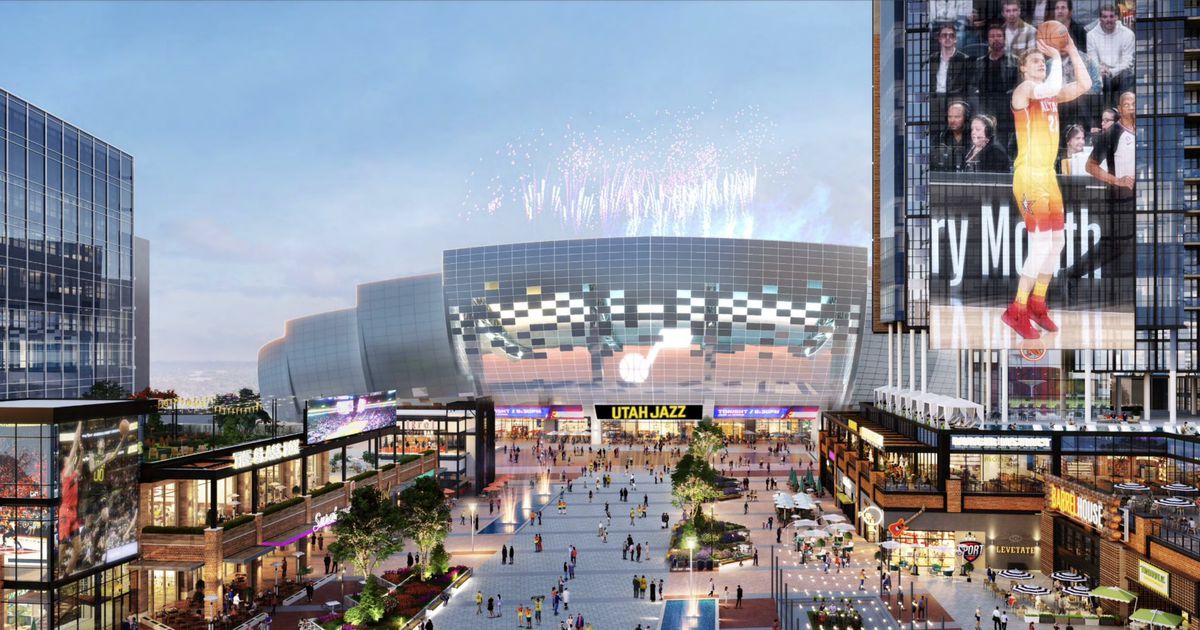A vision of Ryan Smith and his Smith Entertainment Group’s new downtown sports and entertainment district includes tall, gleaming buildings, lining a long promenade leading right to the front door of the Delta Center, the home of the Jazz and Utah’s new professional hockey team.
Missing from the near-futuristic cityscape is 300 West, also known as John Stockton Drive. The six-lane state highway that moves roughly 16,000 cars and trucks per day appears submerged underneath the promenade in renderings presented at a city council meeting earlier this month.
Smith’s group is at least considering burying the heavily-traffic route between North Temple and 100 South, and using the area above the tunnel to install the new pedestrian mall and entertainment district depicted in the rendering of the district.
Smith’s representatives have been careful to emphasize that they are preliminary proposals and not the final product. A spokesperson for SEG reiterated that point when asked to comment on plans for 300 West.
But sinking the state highway is more than a fleeting notion, as earlier this month SEG’s planners were gathering data on the feasibility of the concept.
Robert Stewart, Utah Department of Transportation’s regional director over Salt Lake City, said in an interview that he was initially asked during the legislative session to come up with a cost estimate of what it would take to build a tunnel along the stretch of 300 West — and to put the projection together in the matter of a day or two.
“It’s in the hundreds of millions,” he said. “I’d hate to put a one or two or three or four or five in front of that, but it’s in the hundreds of millions.”
More recently, he said, a traffic engineer hired by Smith to put together the traffic plan for the district contacted him again about the concept to figure out what the transportation department’s needs were for that road.
“I commented that 300 West is a pretty important route for us,” he said.
Along with State Street, he said, it is one of the two main north-south arterials through downtown Salt Lake City and “we can’t force more traffic over to State Street because it’s already at capacity in the North Temple area.”
Also, because it is a state highway, it has to accommodate everything from motorcycles to box trucks to big rigs, he said.
Jon Larsen, transportation director for Salt Lake City, said if the Legislature wants to fund the project the city would be eager to help make it happen.
“Generally speaking, we’re supportive of anything that improves the human experience downtown, walkability and reducing barriers and making it safe and comfortable to move around downtown,” he said. “I think that’s the main objective with tunneling 300 West, so that’s something we’d be excited about and interested in.”
There are details that would need to be worked out — where the tunnel drops down and comes out, the TRAX line it would run beneath and groundwater issues, to name a few.
“There are a lot of technical things to work through, but at the end of the day, if that means there’s this nice cohesive connection between the Delta Center and the cultural core of the district, that would be pretty cool,” Larsen said.
Soren Simonsen, who teaches urban planning at the University of Utah and is a board member for the Utah Chapter of the Congress for New Urbanism, said there are examples of cities like Chicago and Washington, D.C., that use tunnels to move traffic and maintain a walkable city.
And there are an increasing number of examples where cities have put highways underground or phased them out in favor of a more pedestrian-friendly alignment.
In Boston, the Big Dig project rebuilt a 7.5-mile corridor of interstate highways, running about half of it through tunnels, although the program was plagued with cost overruns and engineering problems, ultimately making it the most expensive highway project in history at the time.
Other cities like San Francisco, Seattle and Portland have also reopened large swaths of space by moving highways underground.
“I certainly understand and sympathize with the idea of reducing some of the traffic when you’re trying to create a more pedestrian-friendly environment and connect parts of downtown where major thoroughfares like 300 West are a real barrier,” Simonsen said.
Salt Lake City has been working for years to make downtown more pedestrian-friendly, Simonsen said, but those plans have been at odds with UDOT, which is more focused on moving cars and trucks than encouraging pedestrian and bicycle traffic.
“Every large city has to deal with this and there are less expensive ways to do it and more expensive ways to do it,” he said. “If the sky’s the limit and you don’t have a budget constraint, sure, put the heavy vehicles underground and remove that conflict.”
But in terms of opening up the west side of the city, he said a better proposal is the Rio Grande Plan’s vision of burying the railroad tracks that run west of downtown, creating better traffic flow and freeing up 75 acres of developable space.
“To me, those are much more impactful,” he said. “If you’re going to invest that kind of money, that’s where I’d put it.”










